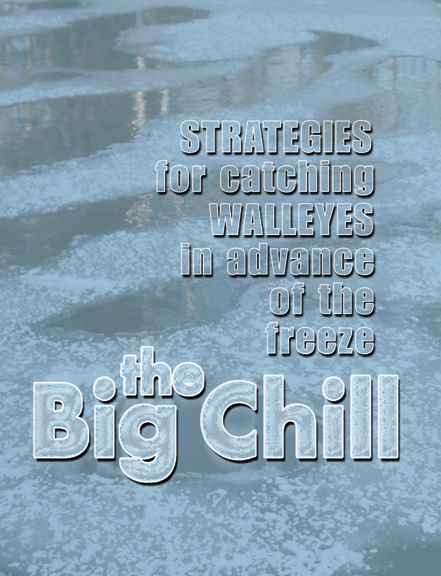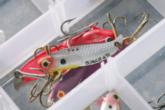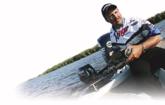The big chill
Strategies for catching walleyes in advance of the freeze

There is a serious chill in the air. Some days the wind howls, blowing a few snowflakes about. It is late fall in the North Country, and hard water is not far off.
This time of year provides some of the best walleye fishing of the entire season. In the increasingly colder water, walleyes chow down on available prey. Sometimes the fish are feeding shallow and sometimes deep, depending on the characteristics of the particular lake. It is the last hurrah for walleye anglers before the ice hits.
There can be significant differences in walleye location this time of year, depending on the specific waters you fish. On the majority of large, manmade reservoirs, walleyes move into the upper third of the impoundment and into tributary rivers, staging below the first upstream dam. On the Great Lakes, walleyes head to current areas around the mouths of tributaries where preyfish are congregating. In some other natural lakes and reservoirs (particularly ones without major tributaries), walleyes may follow baitfish to deep-water humps perhaps 25 feet and deeper, or pull an about-face and head to shallow rock piles.
With the tournament season concluded, professional anglers do not have to be on the water at this time of year. Those who tackle walleyes before ice-up do it simply for fun and the opportunity to catch a big ‘eye. Patrick Byle, Gerrick McComsey and Chris Gilman – three of the Wal-Mart FLW Walleye Tour’s finest competitors – offer their advice on strategies for late-season walleyes.
“Most of my late-season fishing is on the bays of the Great Lakes, particularly in Little Bay and Big Bay de Noc and around river mouths in Green Bay,” Byle said. “Here, walleyes may be scattered over a wide area, with some fish shallow and some deep. That’s why I prefer to troll crankbaits.”
With water temperatures in the mid-and-upper 40s, Byle employs diving crankbaits that have a more aggressive action. “I like the longer, minnow-shaped baits with a large spoonbill lip at this time of year, trolled either on monofilament or FireLine,” he said. “I may troll as fast as 2.3 to 3 mph – especially if the fish are shallow.”
 As temperatures continue to slip (or sometimes plunge) downward, however, Byle switches to small-lip stick baits that have more subtle action. These baits only dive between 2 to 6 feet on monofilament or FireLine, so to put them deeper, he runs them on lead-core line.
As temperatures continue to slip (or sometimes plunge) downward, however, Byle switches to small-lip stick baits that have more subtle action. These baits only dive between 2 to 6 feet on monofilament or FireLine, so to put them deeper, he runs them on lead-core line.
“With temperatures in the mid-40s and lower, I may be trolling 1 1/4 to 1 3/4 mph – sometimes only 1 mph,” Byle said. “At these speeds, it’s the stick baits that have the subtle little side-to-side roll needed to trigger a coldwater strike. Lead core is the only way to get them to the fish, particularly if walleyes are at 25 or even 30 feet.”
As for color choices, Byle opts for more natural colors of blues, purples, blacks and silvers if the water is clear or stained. He only breaks out the brighter patterns when confronted with turbid, dirty water.
Gerrick McComsey on long-lining jigs
South Dakota’s Lake Oahe is Gerrick McComsey’s pick for late fall. Here he fishes deep for walleyes before the ice.
 McComsey explains it this way: “When the surface water is 33 to 36 degrees on Lake Oahe, you will find warmer water deeper. If you study the depth finder, there still appears to be a thermocline down in the 25- to 35-foot range, even as the surface water nears freezing. The smelt are down there, so that is where a portion of the walleye population is still holding.”
McComsey explains it this way: “When the surface water is 33 to 36 degrees on Lake Oahe, you will find warmer water deeper. If you study the depth finder, there still appears to be a thermocline down in the 25- to 35-foot range, even as the surface water nears freezing. The smelt are down there, so that is where a portion of the walleye population is still holding.”
His most productive technique is long-lining jigs with a 7 1/2-foot spinning rod and 6-pound-test line. McComsey rigs either a 3- or 4-inch Berkley Power Minnow on a 1/4- or 3/8-ounce leadhead. He believes the Power Minnow is one of the best representations of smelt.
Using his depth finder, McComsey locates the depth at which bait are holding and moves to where that depth level contacts the bottom. He makes a long cast, allowing the jig to settle on the bottom in the 25- to 35-foot range. Then he begins a slow troll with the bow electric motor, playing out additional line so the jig just ticks bottom occasionally. He regularly snaps the rod to pop the jig during the trolling pass.
“These walleyes don’t come up in the fall; you’ve got to go deep after them,” McComsey said. “Long-lining a jig produces far better than vertical jigging.”
Late-fall walleye fishing is all about location, says Chris Gilman. “Every lake is a little different,” Gilman said. “The technique used depends on the location of walleyes in the body of water you are fishing. When I must go deep, rigging big minnows is very effective for me.”
He says Leech Lake in Minnesota is one example of where rigging minnows is productive. “When the weeds start dying, the walleyes move to deep structure,” he said. “They will be hanging out on the edge of humps in 20 to 30 feet of water. Big redtail chubs are hard to beat.”
Gilman’s outfit consists of a 7-foot spinning rod with 8-pound-test line. He will drop down to 6-pound if the water is unusually clear. “A longer rod is critical for solid hooksets because they take up more line on the sweep,” he said. “I may even go to a 7 1/2-foot rod.”
He employs a 4-foot snell and a heavy walking sinker. Up to a 3/4-ounce sinker is used in order to keep the rig nearly vertical beside the boat. The heavy sinker reduces the amount of line out, thereby increasing bite detection as well as allowing him to fish an area quickly and cover water.
“Because I’m using big redtail chubs – the bigger the better – I rig my bait a little differently,” Gilman said. “I tie on a No. 2 bait hook, which is hooked through the nose of the chub. But I add a stinger snell with a No. 10 or No. 12 treble, which I stick in the dorsal fin. If you do not use a stinger on big bait, you’ll get back a lot of `raked’ chubs because the walleye didn’t get its mouth entirely around the big bait. The stinger is absolutely necessary when using minnows of this size.”
Wait until dark
Both Gilman and Byle acknowledge that nighttime may also be the right time for walleyes in the late fall.
“A lot of walleye feeding takes place at night on some waters,” Gilman said. “For example, at Mille Lacs, during the full moon just before ice-up, big walleyes move onto rock piles in very shallow water after dark to eat yellow perch. At Little Bay de Noc, walleyes suspend over the basin during the day and then after dark move to the reefs to dine on perch.”
Gilman concurs with Byle that the hard-bait choice for daytime trolling this time of year also extends to after dark. “Natural baitfish color patterns are preferred over wild colors,” he said. “As the water gets colder, you must move away from the hard-action, shad-type crankbaits and go to the slow-wobble stick baits like a Rapala. There is nothing as exciting as having a big walleye blow up on your shallow-running lure in the dark!”
Use big baits.
“I use bigger baits in the fall than any other time of the year because the fish are bigger,” Byle said. “For example, go with a No. 13 Rapala rather than No. 7 or No. 9.”
A vertical option
For more than 50 years, Pymatuning Lake in northwestern Pennsylvania has maintained a reputation for walleye fishing. This 13,000-acre, 28-foot maximum depth reservoir was cursed or blessed (depending on your point of view) with the introduction nearly a quarter of a century ago of gizzard shad that have overrun the lake. With water temperature falling into the 40s, massive schools of shad move to the deeper, lower third of the lake, seeking warmer water. As water temperatures continue to drop, many shad begin to die. Each dying baitfish struggles upward, only to fall back toward the bottom. It becomes a feeding frenzy for walleyes.
Now the angling focus turns to the lower part of the reservoir, where aggressive ‘eyes can be found in depths from 10 to 25 feet right up to ice-up. Almost every angler will be vertical-jigging a blade bait on fish-holding areas such as points, hard-bottom rises and deep flats along the river channel. As you look across the fleet of boats, it appears everyone is working an old water-pump handle – each rod arm is going up and down, as the blade is swept upward several inches and then set back down.
 The Heddon Sonar is the most popular brand among the longtime faithful, although an assortment of other upstart blade names can now be found among angling newcomers.
The Heddon Sonar is the most popular brand among the longtime faithful, although an assortment of other upstart blade names can now be found among angling newcomers.
Spinning gear with 10-pound-test line and a 3/8-ounce blade is the preferred setup. If the wind kicks up waves, anglers move to a 1/2-ounce model. The biggest argument among anglers is which blade patterns are best. Some insist on unpainted, shiny, bare metal; others demand a painted shad or perch finish. Still others will use any color as long as it is chartreuse!
The blade is attached to the line with a round-bend snap. To reduce line twist (that is inevitable when vertical jigging), tie a small ball-bearing swivel in-line about 15 inches above the blade.
The late-season jigging of blade baits for walleyes is popular (as well as very productive) on other regional walleye lakes, including Pennsylvania’s Lake Arthur and Allegheny Reservoir and New York’s Chautauqua Lake.


